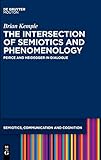The Intersection of Semiotics and Phenomenology : Peirce and Heidegger in Dialogue / Brian Kemple.
Material type: TextSeries: Semiotics, Communication and Cognition [SCC] ; 20Publisher: Berlin ; Boston : De Gruyter Mouton, [2019]Copyright date: ©2019Description: 1 online resource (XIII, 338 p.)Content type:
TextSeries: Semiotics, Communication and Cognition [SCC] ; 20Publisher: Berlin ; Boston : De Gruyter Mouton, [2019]Copyright date: ©2019Description: 1 online resource (XIII, 338 p.)Content type: - 9781501514333
- 9781501505072
- 9781501505171
- 302.2 23
- P99 .K46 2019
- online - DeGruyter
- Issued also in print.
| Item type | Current library | Call number | URL | Status | Notes | Barcode | |
|---|---|---|---|---|---|---|---|
 eBook
eBook
|
Biblioteca "Angelicum" Pont. Univ. S.Tommaso d'Aquino Nuvola online | online - DeGruyter (Browse shelf(Opens below)) | Online access | Not for loan (Accesso limitato) | Accesso per gli utenti autorizzati / Access for authorized users | (dgr)9781501505171 |
Browsing Biblioteca "Angelicum" Pont. Univ. S.Tommaso d'Aquino shelves, Shelving location: Nuvola online Close shelf browser (Hides shelf browser)

|

|

|

|

|

|

|
||
| online - DeGruyter Pragmatics at its Interfaces / | online - DeGruyter Language Play in Contemporary Swedish Comic Strips / | online - DeGruyter The Morphosyntax of Albanian and Aromanian Varieties : Case, Agreement, Complementation / | online - DeGruyter The Intersection of Semiotics and Phenomenology : Peirce and Heidegger in Dialogue / | online - DeGruyter Linguistic Variation: Structure and Interpretation / | online - DeGruyter PHILOSOPHIA in der Konkurrenz von Schulen, Wissenschaften und Religionen : Zur Pluralisierung des Philosophiebegriffs in Kaiserzeit und Spätantike / | online - DeGruyter An Ox of One's Own : Royal Wives and Religion at the Court of the Third Dynasty of Ur / |
Frontmatter -- Preface -- Contents at a glance -- Contents in detail -- General introduction: the question of intellectual progress -- 1. Historical and theoretical introduction -- Division I: World -- Introduction -- 2. Phenomenology as fundamental ontology -- 3. Sein and knowledge -- Division II: Sign -- Introduction -- 4. Categories of experience -- 5. Synechism and the modes of existence -- Division III: World and sign -- Introduction -- 6. Sein and the categories of experience -- 7. Semiotic continuity of the world -- Conclusion: Viae inventionis et resolutionis -- Appendices -- References -- Index
restricted access online access with authorization star
http://purl.org/coar/access_right/c_16ec
Many contemporary explanations of conscious human experience, relying either upon neuroscience or appealing to a spiritual soul, fail to provide a complete and coherent theory. These explanations, the author argues, fall short because the underlying explanatory constituent for all experience are not entities, such as the brain or a spiritual soul, but rather relation and the unique way in which human beings form relations. This alternative frontier is developed through examining the phenomenological method of Martin Heidegger and the semiotic theory of Charles S. Peirce. While both of these thinkers independently provide great insight into the difficulty of accounting for human experience, this volume brings these insights into a new complementary synthesis. This synthesis opens new doors for understanding all aspects of conscious human experience, not just those that can be quantified, and without appealing to a mysterious spiritual principle.
Issued also in print.
Mode of access: Internet via World Wide Web.
In English.
Description based on online resource; title from PDF title page (publisher's Web site, viewed 25. Jun 2024)


